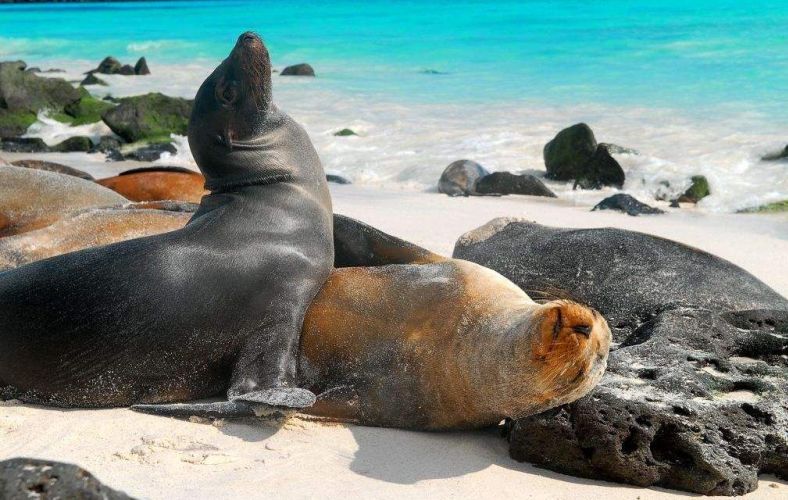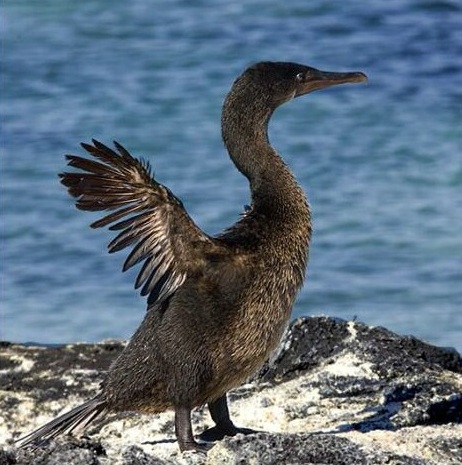Flightless Cormorant of the Galapagos Islands
Flightless Cormorant Data:
ORDER
Pelecaniform.es
FAMILY
Phalacrocoracidae
GENUS & SPECIES
Phalacrocorax harrisi
FEATURES
The Galapagos Flightless Cormorant or the flightless cormorant, scientifically known as Phalacrocorax harrisi, is a cormorant bird native to the Galapagos Islands and mainly found on Fernandina and Isabela Islands. This bird evolved in an isolated island environment that was free of predators. Over time, the wings of this cormorant have become greatly reduced and are now about the size of penguin flippers. By gradual evolution, these birds felt no need to fly and eventually lost their flight. This Flightless Cormorant is now one of the rarest bird in the world.
• These birds are great swimmers with strong webbed feet that make them fantastic on and inside the water
• They live near the shores where they have full access to food in waters near its isolated Galapagos Islands habitat
• Often rests with its stubby wings spread out to dry, as do birds that fly
• Wings have evolved very small, that are now useless for flight
The Galapagos cormorant is the only and unique among the cormorants to have lost the ability to fly. They are big water birds, body is elongated and usually 89 – 100 cm in length. The legs are short and set-back with large, webbed feet. For the ease of catching fish underwater, necks are modified to longer in length; and beak is long and hooked. They can be very difficult to recognize when they are in the water, as they hold their body low, sometimes with only the head and neck showing. After returning to land from a period of feeding at sea they habitually hold their wings out to dry. The Flightless Cormorant is the largest cormorant in the world. The sexes of these birds are alike.
WHERE YOU CAN FIND FLIGHTLESS CORMORANT
Found only on the rocky shorelines and inshore waters of Fernandina Island and Isabela Island, 2 of the 13 main islands in the Galapagos
HABITAT
The Galapagos Islands are home to many unique animal species found nowhere else in the world, including the flightless cormorant. These islands lie in the Pacific Ocean about 600 miles off the eastern coast of South America. The flightless cormorant is limited to only Fernandina Island and the western and northern coasts of Isabela Island, 2 of the 13 islands of Galapagos. They enjoy to be near the ocean so you can see their shelters and nests along rocky coastlines. The flightless cormorant favors a relatively cool, dry climate.
FOOD
It feeds exclusively on marine life in the cold, food-rich inshore waters. The cormorant is an efficient daytime hunter with a voracious appetite. It feeds mainly on fish, octopus, squid and eel, along with the occasional invertebrate and crustacean. The bird dives and expertly swims after its prey. The indigestible parts of its prey, such as scales and bones, are regurgitated as pellets. While the flightless cormorant has totally lost the power of flight, it has become a skilled swimmer and developed stronger feet than other cormorants. On land, the flightless cormorant waddles clumsily due to the shortness of its legs and its large, webbed feet; underwater it is swift and graceful
Reciente
- Islas Galápagos tiene el Primer Transporte Marítimo Eléctrico Solar “Catamarán”
- The Galapagos Islands have the most Hummer Sharks in the world
- Las Islas Galápagos tiene la Mayor Concentración de Tiburones Martillo del Mundo
- New Galapagos Giant tortoise species identified
- Climate and Precipitation in the Galapagos Islands
Términos Populares
Aeropuerto conservacion Darwin Deals Ecuador ekwador Energia energía eólica equador Equipo Evolution Fernandina Fly Galapagos Genovesa geografica Geographic Guayaquil Historia Information Isabela Island Islands Islas Isla Santa Cruz location medio ambiente Puerto Ayora Quito reciclaje Recycling renovable SailBoat San Cristobal Santa María Tour Tourist Tours Travel Trip Tsunami Turismo Turista Ubicacion VisitantesAnunciantes










